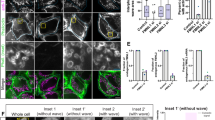Abstract
The SH2 and SH3 binding partner AFAP-110 is a tyrosine phosphorylated substrate of Src. AFAP-110 has been hypothesized to link Src to actin filaments, which may contribute to the effects of Src upon actin filament integrity. However, it has been unclear what effect activated Src (Src527F) has upon AFAP-110 structure or function and whether AFAP-110 plays a role in actin filament integrity. We report here that the carboxy terminal 127 amino acids of AFAP-110 are comprised of an α-helical region that contains a leucine zipper motif. This indicated the potential of AFAP-110 to self-associate. Expression of the carboxy terminus as a fusion protein (GST-cterm) will permit affinity absorption of cellular AFAP-110. The integrity of the α-helical leucine zipper motif in GST-cterm is required for affinity absorption, but binding is not due to a classical leucine zipper interaction. Co-expression of Src527F, unlike cSrc, will abrogate affinity absorption of AFAP-110 with GST-cterm. These data indicate that Src527F has affected a change in the carboxy terminal structure that renders AFAP-110 unavailable for affinity absorption. Superose chromatography demonstrate that AFAP-110 will fractionate as a monomer or multimer, indicating AFAP-110 can be detected in a self-associated form in cell lysates. Co-expression of Src527F resulted in AFAP-110 fractionating with a molecular weight that predicts only a multimeric population. Deletional mutagenesis also indicate a biological role for the carboxy terminus in cellular localization and actin filament integrity. Deletion of the entire carboxy terminal α-helix (84 amino acids) will not permit AFAP-110 to efficiently colocalize with actin filaments or the cell membrane. Deletion of only the leucine zipper region of the carboxy terminal α-helix (44 amino acids) from AFAP-110 (AFAPAΔzip) demonstrate that both AFAPΔlzip and actin filaments are repositioned into rosette-like structures, similar to the effects of Src527F, while co-expression of AFAP-110 with cSrc will not affect actin filaments. These data indicate that AFAP-110 can play an important role in modulating actin filament integrity through carboxy terminal interactions that can be affected by Src527F.
This is a preview of subscription content, access via your institution
Access options
Subscribe to this journal
Receive 50 print issues and online access
$259.00 per year
only $5.18 per issue
Buy this article
- Purchase on Springer Link
- Instant access to full article PDF
Prices may be subject to local taxes which are calculated during checkout
Similar content being viewed by others
Author information
Authors and Affiliations
Rights and permissions
About this article
Cite this article
Qian, Y., Baisden, J., Westin, E. et al. Src can regulate carboxy terminal interactions with AFAP-110, which influence self-association, cell localization and actin filament integrity. Oncogene 16, 2185–2195 (1998). https://doi.org/10.1038/sj.onc.1201753
Received:
Revised:
Accepted:
Published:
Issue Date:
DOI: https://doi.org/10.1038/sj.onc.1201753
Keywords
This article is cited by
-
Long non-coding RNA AFAP1-AS1 plays an oncogenic role in promoting cell migration in non-small cell lung cancer
Cellular and Molecular Life Sciences (2018)
-
Actin filament-associated protein 1 is required for cSrc activity and secretory activation in the lactating mammary gland
Oncogene (2015)
-
The actin-binding domain of actin filament-associated protein (AFAP) is involved in the regulation of cytoskeletal structure
Cellular and Molecular Life Sciences (2012)
-
Identification of AFAP1L1 as a prognostic marker for spindle cell sarcomas
Oncogene (2011)
-
Iron oxide nanoparticles induce human microvascular endothelial cell permeability through reactive oxygen species production and microtubule remodeling
Particle and Fibre Toxicology (2009)



